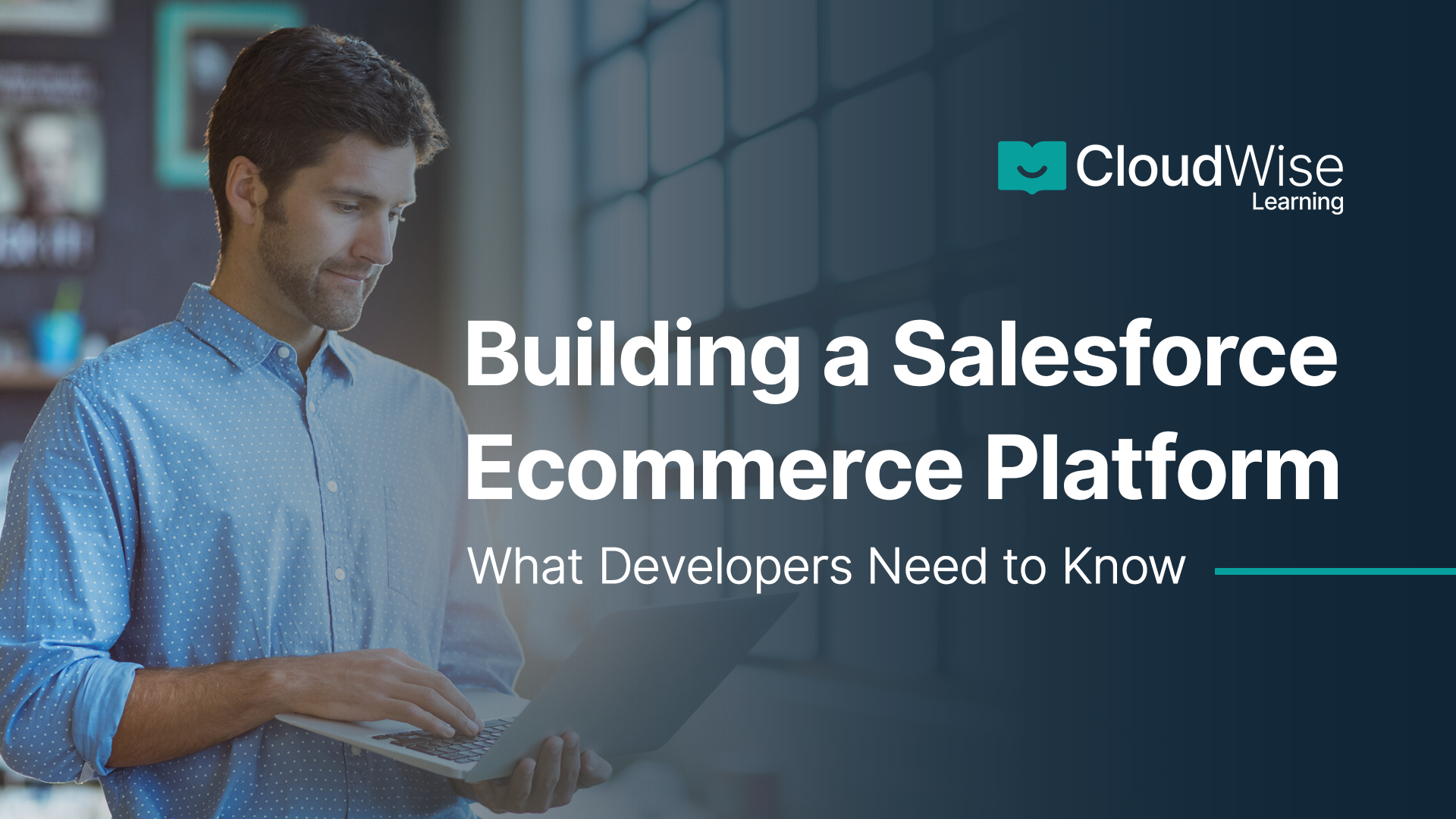No products in the cart.
Building a Salesforce eCommerce Platform: What Developers Need to Know

Global data indicates that eCommerce revenue will reach approximately 1.23 trillion U.S. dollars by 2029. As eCommerce continues to dominate global markets, businesses must implement scalable, customer-centric solutions to remain competitive. Platforms like Salesforce eCommerce provide essential tools and features for creating, managing, and optimizing online stores, marketplaces, and digital commerce operations. Understanding how to utilize this powerful platform is vital for developers and businesses, as it helps them deliver exceptional customer experiences and drive business growth.
Here is a comprehensive guide for developers and businesses to get started with the Salesforce eCommerce platform.
What is the Salesforce eCommerce Platform?
Over 28 million e-commerce sites are operating worldwide this year, a 2.9% increase from the previous year. The Salesforce E-commerce Platform offers a powerful solution for businesses looking to create and manage online stores and digital marketplaces. It integrates smoothly with Salesforce’s ecosystem, which includes tools such as CRM, Marketing Cloud, and Service Cloud, providing a unified and scalable solution for e-commerce operations.
Key Features:
-
B2C and B2B Commerce: Tailored solutions for both consumer-facing and business-to-business operations.
-
AI-Powered Personalization: Leverage Einstein AI to deliver tailored product recommendations and personalized experiences.
-
Seamless Integrations: Connect with Salesforce tools for unified data management and customer insights.
-
Scalability: A flexible, mobile-responsive design ensures businesses can grow without limitations.
These features provide developers with the tools to create innovative, efficient, and engaging digital commerce solutions.

Why Businesses Choose Salesforce for eCommerce
Salesforce eCommerce Platform stands out for its ability to deliver measurable business results. Here’s why businesses turn to Salesforce:
- Unified Customer Experience: Salesforce connects customer data across sales, marketing, and service channels to ensure consistency.
- Customizability: Businesses can tailor their platforms to meet specific industry or customer needs.
- Faster Time-to-Market: Prebuilt templates and tools accelerate the development process.
- Global Reach: Support for multiple languages, currencies, and payment gateways simplifies international expansion.
With these advantages, businesses can meet customer demands more effectively while boosting operational efficiency.
Steps to Building a Salesforce eCommerce Platform
Building a Salesforce eCommerce platform requires a thoughtful approach to ensure it meets the demands of modern consumers while aligning with business objectives. Following a structured process, developers can create a seamless, scalable, and efficient platform that supports personalized shopping experiences and business growth. Below are the essential steps to get started:
1. Set Up the Platform
- Choose Your Commerce Model: Decide whether Salesforce B2C Commerce or B2B Commerce best aligns with your business needs. For example:
- B2C Commerce: Ideal for retail businesses focusing on customer-centric shopping experiences.
- B2B Commerce: Perfect for wholesale operations or businesses with complex purchasing processes.
- Configure Salesforce Integration: Connect your platform seamlessly with CRM, Marketing Cloud, and other tools for streamlined data flow and a 360-degree customer view.
- Set Up Essential Features: Organize product catalogs and configure payment gateways, shipping rules, and tax regulations to ensure a smooth checkout experience.
2. Customize and Develop
- Harness Salesforce APIs and Custom Objects: Use Salesforce’s robust API library to customize workflows, integrate third-party applications, and extend platform functionality.
- Leverage Einstein AI: Implement AI-powered features like personalized product recommendations, predictive analytics, and customer behavior insights for a tailored shopping experience.
- Incorporate Advanced Features: Add multi-language, multi-currency support, and automation tools to meet global and operational demands.
3. Design for Scalability and User Experience
- Mobile-First Design: Prioritize mobile responsiveness to cater to the growing number of on-the-go shoppers.
- Responsive Architecture: Ensure your platform can handle increasing traffic, seasonal spikes, and evolving business requirements.
- Seamless Navigation and Search: Design intuitive navigation and robust search tools to help customers find products effortlessly.
4. Test, Launch, and Optimize
- Comprehensive Testing: Conduct functional, security, and performance tests to ensure your platform runs smoothly and securely under varying conditions.
- Data-Driven Refinements: Salesforce’s built-in analytics tools monitor user behavior and optimize the platform post-launch.
- Iterative Improvements: Continuously update the platform based on customer feedback and performance metrics to stay competitive.
5. Provide Continuous Support and Innovation
- Automated Customer Support: Integrate chatbots, live chat, and self-service options to provide round-the-clock assistance.
- Scale with Business Growth: As your business expands, leverage Salesforce’s tools to add new regions, currencies, and advanced features.
- Stay Updated: Regularly update the platform with new capabilities, security patches, and innovative tools.
By following these steps, businesses can build a robust, scalable, and customer-focused eCommerce platform that adapts to market needs and drives growth.
Advanced Features to Leverage
To maximize the potential of the Salesforce eCommerce Platform, developers should incorporate advanced features:
- Salesforce Order Management: Simplify order tracking, fulfillment, and returns.
- Customer 360 Data Model: Create unified customer profiles for more targeted and personalized interactions.
- AppExchange Integrations: Expand functionality with third-party apps and solutions.
These tools enhance the platform’s functionality, streamline operations, and improve customer satisfaction.

Overcoming Key Challenges Developers Face with Salesforce eCommerce.
Developing and implementing a Salesforce eCommerce Platform presents unique challenges. From integration complexities to staying updated with the platform’s continuous evolution, these obstacles can impact the project’s efficiency and success. However, with the right strategies and resources, developers can overcome these hurdles and deliver seamless eCommerce solutions.
1. Integration Complexity
Integrating the Salesforce eCommerce Platform with legacy systems can be challenging. Developers should:
- Use Salesforce’s API documentation.
- Work closely with IT teams to ensure smooth data migration.
2. Managing Large Data Sets
Handling extensive customer data requires precision. Best practices include:
- Implementing advanced validation rules.
- Using data deduplication tools to maintain data quality.
3. Balancing Customization with Scalability
Over-customization can lead to performance issues. Focus on scalable solutions that align with business goals while keeping customization manageable.
4. Staying Updated
Salesforce frequently updates its platform. Developers should:
- Attend Salesforce events like Dreamforce.
- Leverage resources like Trailhead for continuous learning.
By addressing these challenges proactively, developers can ensure a smooth implementation process.
Why Invest in Salesforce eCommerce Expertise?
1. For Developers
- Career Growth: Salesforce skills are in high demand, and expertise in eCommerce development opens up lucrative opportunities.
- Certifications: Pursuing certifications offered by Cloudwise Learning, such as Salesforce Administrator or Platform App Builder, equips developers with the knowledge to thrive in eCommerce projects and boosts their credibility and job prospects.
2. For Businesses
- Operational Efficiency: Skilled developers ensure platform optimization for performance and scalability.
- Competitive Advantage: Leveraging Salesforce’s capabilities enables businesses to deliver superior customer experiences.
Achieving Superior Customer Experiences with Cloudwise Learning
As of 2024, there are over 5.5 billion internet users worldwide, leading to an unprecedented demand for seamless and personalized online shopping experiences. To stay competitive in this rapidly expanding digital marketplace, businesses require long-term and scalable solutions, and the Salesforce eCommerce Platform provides precisely that. However, harnessing its full potential requires skilled professionals who can effectively utilize its advanced features.
Cloudwise Learning offers expert-led training to equip developers and businesses with the practical skills necessary for success. By combining hands-on learning with real-world scenarios, participants gain the expertise to build and optimize eCommerce platforms that meet modern consumer expectations. From foundational tools to advanced techniques, Cloudwise Learning prepares professionals to streamline operations, integrate cutting-edge features, and deliver exceptional customer experiences.
Furthermore, Cloudwise Learning supports career advancement by helping professionals earn valuable Salesforce certifications, such as Salesforce Administrator or Platform App Builder. These credentials validate expertise, enhance career prospects, and provide a competitive edge in a constantly evolving job market. Businesses that invest in training through Cloudwise Learning can position themselves to stay ahead, optimize their eCommerce platforms, and drive innovation and operational efficiency.
Ready to transform your eCommerce success? Contact us today to master Salesforce solutions with Cloudwise Learning!
Explore Our Other
Resources
Dive into our Resource Center, where you can explore a wealth of expert blogs. Discover detailed industry insights and stay informed on the latest trends. Enrich your knowledge with our comprehensive resources.
